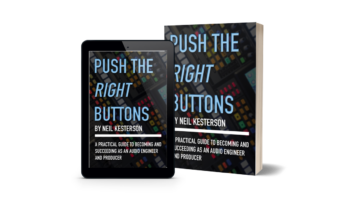
Arno Meyer, left, and Mark Grant, designer of Belar’s FMCS-1, at a recent NAB convention.
For more than 45 years, Belar Electronics Labs in Pennsylvania has sought to raise the bar in standards of monitoring technical parameters of broadcast signals, whether AM, FM or TV.
Its president and founder Arno Meyer developed an interest in electronics and high fidelity at an early age. He earned an undergraduate degree in physics from the University of California at Santa Barbara, and later attended classes at the Moore School of Engineering at the University of Pennsylvania in Philadelphia. While attending school, he worked part-time for Jerrold and B&W.
Despite the early interest in broadcasting and high fidelity, Meyer never got involved with college broadcasting adding, “I’ve never worked for a radio station.”
The birth of FM stereo
Meyer’s first job after school was at ITA, which at the time was involved in military, shortwave, industrial and broadcast electronics. He was hired by Bernie Wise, who is now the president of Energy-Onix, to develop a special transmitter for NASA’s Nimbus project, which involved remote sensing of the Earth with satellites.
“The project involved modifying a 5 kW FM broadcast transmitter to operate at 150 MHz with AM modulation,” recalls Meyer. “Eimac had no test data for the transmitter’s 4CX5000 final tube with those parameters, and basically said ‘Let us know how it works out.'” With some careful design and tweaking, the transmitter worked and was accepted by NASA.
ITA eventually was purchased by Triangle Publishing, a media conglomerate that owned TV Guide and a host of radio and TV stations. The company’s focus shifted more towards broadcasting, and Meyer’s next assignment was to develop the electronics for the ITA Documentor.
“The Documentor was one of the first program audio logging devices,” he said. “It would record 24 hours of audio on a 9-inch disc. Ten years’ worth of these Micro Discs could be stored on a bookshelf five feet long.” One of the most challenging aspects of the design was creating a ceramic cartridge with a 1 mil stylus. Meyer worked with ITA’s mechanical engineer Buddy Wagner on the project.
In the mid-1950s, interest in FM multiplexing or stereo broadcasting had reached the point that the FCC allowed these transmissions on an experimental basis. In the following years, a standard was adopted, and on June 1, 1961, FM stereo broadcasting was authorized by the commission.

Meyer designed ITA’s documentor, one of the first program logging devices. Meyer’s next assignment at ITA was to develop an FM stereo generator. The ITA SG-1D was the result. The 10-1/2-inch rackmount unit used a balanced-bridge modulator circuit with 15 vacuum tubes.
In the process of designing the stereo generator, Meyer had to redesign the ITA FM-10 serrasoid exciter to widen the multiplier bandwidths. As Meyer recalls, “The project was a great success. The stereo generator had a separation greater than 40 dB, from 50 to 15 kc, with the very low audio distortion characteristic of serrasoid exciters.”
With this project, Meyer’s interest in FM stereo was piqued, and he proposed to Roger W. Clipp, vice president of Triangle/ITA Electronics, that the company pursue the wide-open FM stereo monitor market. To his dismay, Clipp informed Meyer he had no interest in continuing in broadcast electronics, and in fact wanted to sell the company. Clipp could find no buyers, and ITA went out of business shortly thereafter.
Basement start
Meyer decided it was time to give notice and set out on his own. In 1964 he founded Belar Electronics Labs in the basement of his Drexel Hill, Pa., home. He explains the origins of the company name, “Belar is a combination of bel — my wife’s name was Isobel — and my name, Arno.”
The company’s first product, the FMD-1, was a tunable FM detector, which demodulated the FM signal to baseband and also had an AM detector for noise measurements. Revenues from the detector were used to fund the development of his first FM monitors, the FMM-1 and FMS-1.
With working prototypes of his FM monitors in hand, Meyer faced his next hurdle.
“All RF monitoring equipment had to have type approval from the FCC before it could be sold to broadcasters.” It turned out he had nothing to worry about. A call from Larry Miller at the FCC’s Laurel, Md., facility confirmed that the Belar monitors not only passed the tests but were better than the commission’s measuring equipment.
Meyer recalls his first sale, “It was to Dave Kurtz at WDVR. It was a huge leap of faith, because he paid in advance for the monitor and didn’t know what he would get.”
With an established product, Belar moved out of Meyer’s basement into manufacturing facilities in Upper Darby, Pa. The product line soon expanded to include AM and TV monitors.

The ITA SG-1D stereo generator was designed by Meyer during his time with ITA. At the time that Belar FM monitors received FCC type approval, monitors from Collins Radio and McMartin Industries had already been approved by the commission. A deadline had been set by the FCC for all stations broadcasting FM stereo to have type approved monitors installed.
Meyer did some calculations and found the deadline to be unrealistic. “We had an attorney present our case to the commission — that two manufacturers could not possibly build enough monitors to meet the deadline, but three manufacturers, with more time, could.” The FCC agreed, and the deadline was pushed back.
It is a testimony to the quality of design and workmanship of the FMM-1 and FMS-1 that many remain in service after 40 years, and regularly return to the Belar factory for repair and recalibration.
Meyer notes that with the passing of time, however, some repairs are no longer possible. “We can’t get the crystal ovens, power transformers or variable capacitors for the VCOs anymore. The original meters are still available from API but cost around $800, so we won’t replace them.”
In the late ’70s, Belar partnered with RCA to develop an AM stereo standard, using the RCA Ampliphase exciter as a test bed. Meyer developed both the generator and decoder, which was shown at the NAB show in Chicago. RCA eventually dropped out of the AM stereo race, but the standard continued as the Belar AM-FM stereo system.

Belar Lab’s first product was the FM detector model FMD-1. As the business expanded, Belar outgrew the facilities in Upper Darby and moved to the Devon plant where it is today. Until recently, all manufacturing was done in house.
“We have our own sheet metal shop, and used to do our own circuit boards, which were plated to a mirror brilliance. All manufacturing is done in small lots, and circuit board assembly was done by hand.” The complexity of today’s multi-layer circuit boards has necessitated that their manufacturing be outsourced.
In 2001 Meyer was presented with the NAB’s Radio Engineering Achievement award, which is given to industry leaders for significant contributions that have advanced broadcast engineering. He also is a member of the Institute of Electrical and Electronics Engineers.
Meyer sums up what he sees as key factors in his company’s success: “Care. Care in design, care in manufacture, care in testing and care in customer service.” Twenty employees work the privately-held company.
Asked what product he is the most proud of, Meyer points to the company’s most recent, the FMCS-1, which uses direct sampling of the RF signal. He adds that the product is the culmination of 20 years of research. “The advent of DSP chips allowed us to replace many of the analog functions in our monitors with DSP processing. It facilitates a much greater degree of accuracy and permits software upgrades.”
The FMCS-1 combines the functions of the FMSA-1, SCMA-1 and RDS-1 stereo, SCA and RDS monitors, along with the frequency agile RFA-4 RF amp.
Will terrestrial FM radio go the way of the dinosaur as Internet-based broadcasting gains in popularity? Meyer is quick to reply, “No, because serious music listeners can hear the differences between the two mediums and will stay with FM.”












